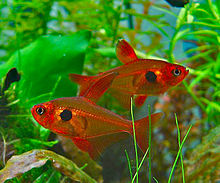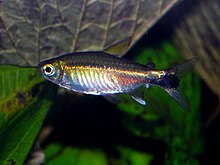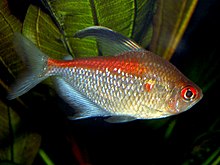
Tetra is the common name of many small freshwater characiform fishes. Tetras come from Africa, Central America, and South America, belonging to the biological family Characidae and to its former subfamilies Alestidae and Lebiasinidae. The Characidae are distinguished from other fish by the presence of a small adipose fin between the dorsal and caudal fins. Many of these, such as the neon tetra, are brightly colored and easy to keep in captivity. Consequently, they are extremely popular for home aquaria.

Hyphessobrycon is a genus of freshwater fish in the family Characidae. These species are among the fishes known as tetras. The genus is distributed in the Neotropical realm from southern Mexico to Río de la Plata in Argentina. Many of these species are native to South America; about six species are from Central America and a single species, H. compressus is from southern Mexico.

Astyanax is a genus of freshwater fish in the family Characidae of the order Characiformes. Some of these fish, like many of their relatives, are kept as aquarium pets and known collectively as tetras. With around 150 described species and new ones being described yearly, this genus is among the largest of the entire order; Hyphessobrycon also has more than 145 species and which one is larger at any one time depends on whether more species have been recently described in one or the other. The blind and colorless cave tetra of Mexico is a famous member of the genus, but its taxonomic position is disputed: Some recognize it as part of the Mexican tetra and this is supported by phylogenetic evidence, but others recognize the cave form as a separate species, A. jordani.

Moenkhausia is a genus of freshwater fish in the family Characidae native to tropical and subtropical South America. These are medium-sized tetras where the largest species only reach around 12 cm (4.7 in).

Chalceus is a genus of fish that inhabits freshwater habitats in South America. Members can be found in the Amazon and Orinoco basins, as well as in the Guianas and various tributaries of the former. It is the sole representative of the family Chalceidae.

Hemigrammus is a genus of freshwater fish in the family Characidae native to South America and commonly seen in the aquarium trade. These are medium-small tetras where the largest species reach up to around 11 cm (4.3 in).
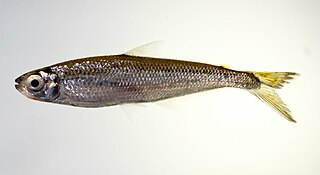
Iguanodectes is a genus of freshwater fish found in tropical South America, with eight currently described species. They are all small tetras, none longer than 5 inches, and often have attractive silvery or striped scales, which makes them a target for the ornamental fish industry. Alongside the genus Piabucus, it is in the subfamily Iguanodectinae, which in turn is in the family Iguanodectidae. The genus Bryconops, which is also in Iguanodectidae, makes up a sister clade to Iguanodectinae.

Petitella is a genus of freshwater fish in the family Characidae of the order Characiformes.

Tetragonopterus is a genus of fish in the family Characidae native to South America.

Ectrepopterus uruguayensis is a small species of characin originally recorded only from streams in Uruguay, with occasional sightings in Brazil and Argentina. It is the only known member of the genus Ectrepopterus, which was formerly a subgenus of Megalamphodus. Given its restricted range, it is considered a rare fish, and is of note for conservation researchers interested in preserving the biodiversity of the region.

Carlastyanax aurocaudatus is a small species of freshwater fish in the family Characidae native to the Río Cauca in Colombia. It is the only member of the monotypic genus Carlastyanax, which was named in 1972 specifically for the species by Jacques Géry. Upon description, it was named Astyanax aurocaudatus by Carl H. Eigenmann. There has been debate concerning whether or not the genus should be recognized, but C. aurocaudatus is currently considered a valid species.
Heiko Bleher is a German researcher, author, photographer, and filmmaker. He is best known in the scientific community for his contribution to the exploration of fresh and brackish water habitats worldwide. He has discovered numerous species of fish and aquatic plant, several of which carry his name or are named in honor of Bleher's family.
Hyphessobrycon borealis is a species of tetra in the family Characidae.

Iguanodectidae is a family of freshwater fish in the order Characiformes that lives in South America. It is home to the subfamily Iguanodectinae and the monotypic Bryconops clade. Several species in the family, such as the green line lizard tetra, the tailspot tetra, and the orangefin tetra, are sometimes taken as aquarium fish.
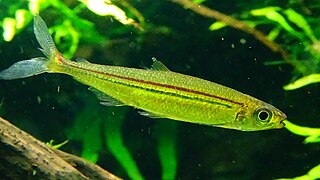
Iguanodectinae is a subfamily of small freshwater fish in the family Iguanodectidae. They are most prominently found in the Amazon river basin and its major tributaries, but they are also known from the Tocantins, Orinoco, and Paraguay rivers. It has two genera, Piabucus and Iguanodectes. Some species in the subfamily are taken from the wild for aquariums, like the red- and green-line lizard tetras. There is minor, but ongoing, debate regarding its taxonomy.
Bryconops durbinae, sometimes listed under the name Bryconops durbini, is a small species of freshwater fish in the family Iguanodectidae. It is the smallest species of the genus Bryconops. Like all members of Iguanodectidae, it inhabits rivers in the upper half of South America.

Bryconops magoi is a small species of fish from South America. It is only found in Venezuela, along with sister species Bryconops collettei. Its tail-fin markings help to differentiate it from various congeners, as does its fairly restricted range. It is most closely related to B. collettei and Bryconops caudomaculatus, and it was once considered synonymous with the latter; specimens of B. magoi and B. collettei both were routinely misidentified as B. caudomaculatus before being given species distinction.

Iguanodectes geisleri, the red-line lizard tetra, is a species of freshwater fish from South America. It is a small species, largely herbivorous with some omnivorous traits, that prefers to live in schools and is partial to shallow waters, especially in blackwater habitats. Some aspects of its body plan are unique amongst its genus, including the position and length of the anal fin.

Astyanax clavitaeniatus is a small species of freshwater fish native to various rivers in the Amazon basin. It is characterized by a club-shaped lateral stripe, which is where it gets its scientific name; "clava" means "club", and "taenia" means "stripe". It is a deep-bodied fish with a silvery base color, which is not uncommon for members of Astyanax. Its markings - including a humeral spot and two vertical brown bars - indicate that it is a part of a species complex centered around congener Astyanax bimaculatus.

Deuterodon heterostomus is a small species of characin endemic to a large river system in southeast Brazil. It was originally the only member of the genus Probolodus, but Probolodus is now considered obsolete, synonymized with Deuterodon. Much like other members of Deuterodon, and like some fish in related genera, D. heterostomus is a small, silvery fish with fins in some combination of red and clear. It has a defined humeral spot that can be used for identification.
